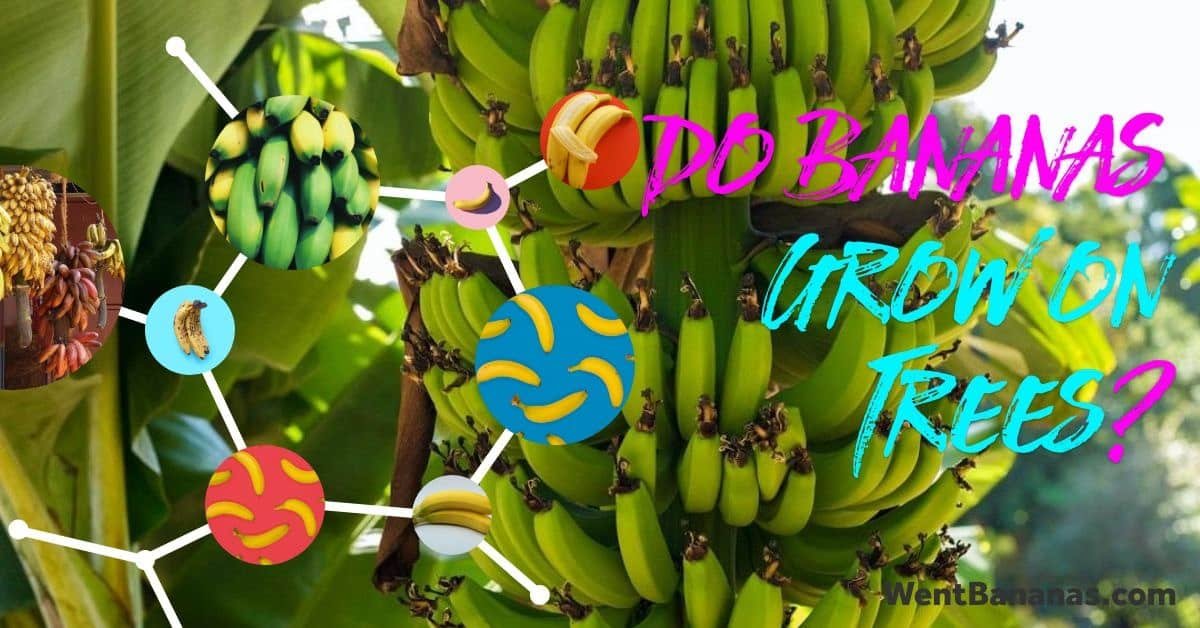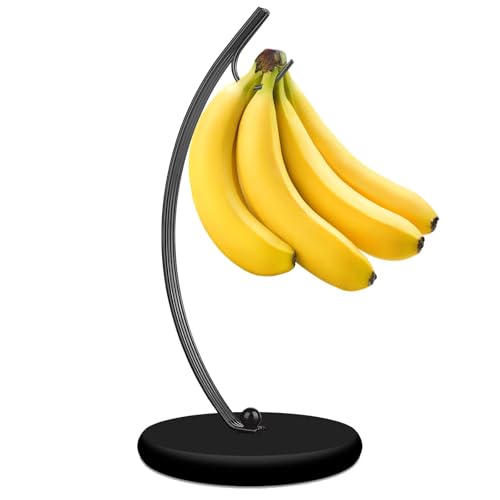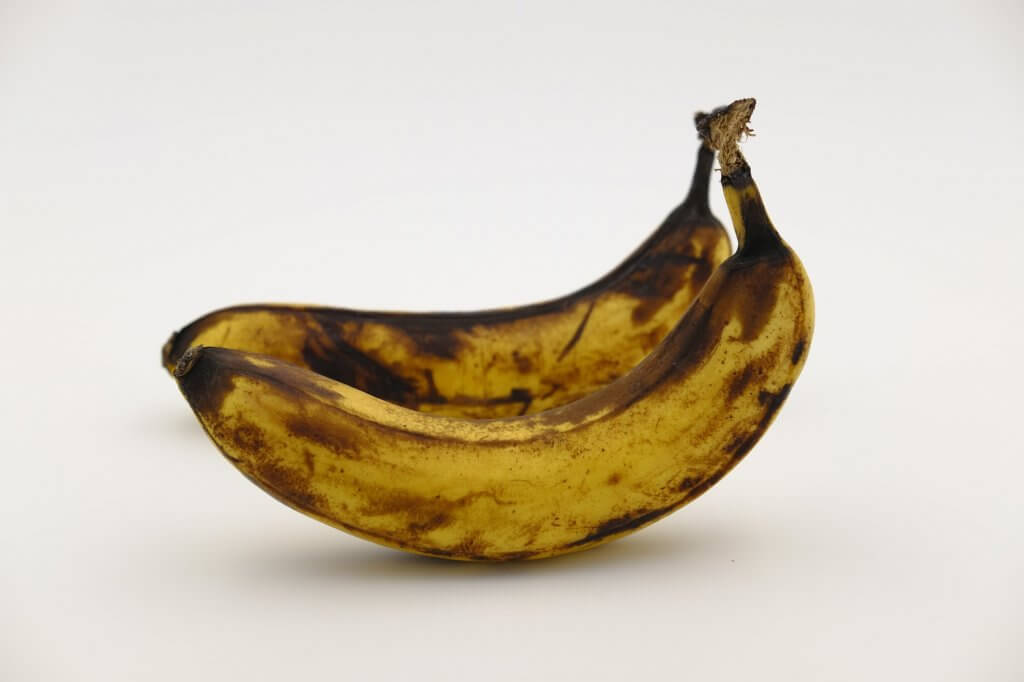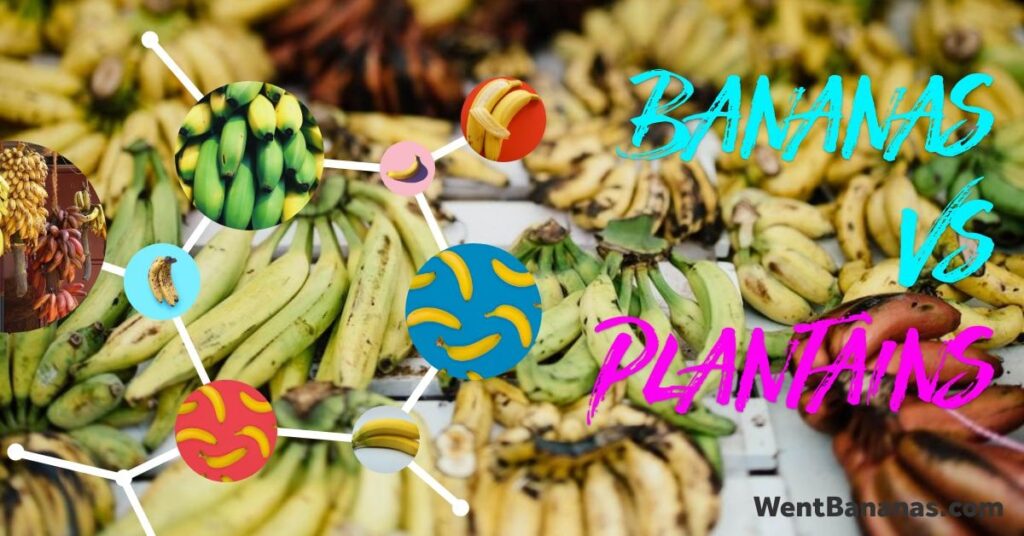Do bananas grow on trees? Well, that is a question that has puzzled many children and adults for ages. The answer to this mystery may surprise you!

Bananas are actually a type of herb, not a fruit. They are grown on plants called banana trees. These trees produce the edible bananas we all know and love. Bananas grow from the root up and can grow to be over 20 feet tall! Let’s find out all the details about what a banana tree really is.
What Do Bananas Actually Grow On?
Bananas are a unique type of fruit that grows on pseudostems, or what looks like towering trees with large leaves. The stems can reach heights up to 15 feet and contain multiple tiers of banana bunches of fruits. Bananas are grown in tropical climates such as India, the Philippines, Central America, and parts of South America where temperatures remain consistently warm year-round.

The actual flower is at the very top part of the pseudostem while the bananas develop from an underground rhizome system known as a corm which produces shoots throughout its life cycle. These shoots produce leafy structures called “hands” – this is where we get individual bananas from!
After harvest season each stalk dies off only to be replaced by new ones coming up through those same rhizomes giving us those iconic towers full of delicious yellow fruits!
Do Bananas Grow on Trees or Palms?
Bananas are unique fruit that is both delicious and versatile. It’s also interesting to note how they grow: the banana plant, or Musa acuminata, is technically not a tree but an herbaceous plant from the genus Musaceae. It belongs to the family of plants called monocots which have leaves with parallel veins rather than branching veins like those found in trees.
The banana itself grows on either a single trunk (called a “corm”) or several stalks coming out of one root system – this arrangement gives bananas their distinctive curved shape and makes them look more like palm trees than typical fruit-bearing vegetation.
At harvest time, farmers cut off all but one stalk so it can bear many fruits at once without having to spread its energy too thin amongst multiple trunks or stems as it would if left uncut.. On average, each stalk produces around 15–20 hands of bananas depending on variety; however, some varieties can produce up to 50 bunches per stem!
Banana plants thrive best in warm climates with plenty of moisture available for sustenance year-round – tropical regions such as Central America and Southeast Asia provide ideal conditions for cultivating these tasty fruits which explain why we can find them so readily available no matter where we live now!
Where Do Banana Trees Grow?
Banana trees are tropical plants that grow best in warm, humid climates with plenty of sunlight and rainfall. The ideal growing conditions for banana trees include temperatures between 70 to 90 degrees Fahrenheit, high humidity levels, and consistent rain or irrigation.
Banana trees can be found in many parts of the world including Central America, South America, Africa, and Asia where these climatic requirements are met.
Banana trees tend to thrive under specific environmental conditions such as moist soil rich in organic matter; adequate sunshine; good drainage facilities; protection from strong winds; low-temperature variations during the flowering time (March-April) and fruit maturing time (August-September); periodic pest control measures like spraying or dusting with insecticides when necessary.
Bananas have a shallow root system so they need an even distribution of moisture throughout the soil profile which allows them access to nutrients at all times for healthy growth. Additionally, fertilizing every few months will ensure your tree has enough nutrient uptake for optimal growth
Is a Banana a Tree or a Bush?

The debate of whether a banana is a tree or a bush has been raging for decades. Botanists and horticulturists are divided on the issue, with some saying that bananas are trees while others argue they’re more like bushes.
The scientific answer lies in understanding the anatomy of the plant itself. A typical banana tree will grow to about 10 feet tall and consists mainly of an underground stem called a corm, multiple aerial stems (called pseudostems) from which leaves emerge, and flower buds at their tips that produce edible fruit after fertilization by pollinating insects.
The trunk-like pseudostem supports numerous long leaves arranged around it in concentric circles whose edges overlap each other to provide shade for its heart—the growing point protected within them where new shoots form flowers and fruits develop during the fruiting season.
Bananas can be classified as perennial herbs because they lack woody tissue. Instead, their stems consist entirely of water-storage parenchyma cells surrounded by fibrous bundles composed largely of sclerenchyma fibers, which give strength against wind damage.
When producing large amounts of foliage above ground level over several years before dying back down again each year after winter dormancy sets in. Once flowering stops around midseason due to temperature changes outside favoring leaf growth over fruit production inside the canopy.
This cycle continues until heavy frosts kill off any remaining immature bunches left unharvested early enough.

What Is a Banana Tree Called?
« Bananas vs Plantains: The Ultimate Comparison
How to Keep Bananas Fresh After Peeling Them: 5 Proven Methods »
A banana tree is a type of perennial herbaceous flowering plant that belongs to the genus Musa. The scientific name for this species is Musa acuminata, which includes some of the most popular varieties found in supermarkets today. Bananas are harvested from these trees and used for food as well as other applications such as papermaking, animal feed, clothing dyeing, and more.
The banana tree has an interesting botanical structure; it grows up to 30 feet tall with leaves reaching 21-26 inches long and 4-6 inches wide at their widest point. Its trunk contains several layers of overlapping bark that protect against sunburns and predators while also allowing water retention throughout its lifespan.
Furthermore, each stem sprouts multiple clusters or “hands” full of bananas on top – each hand containing 10-20 individual fruits! As if all this isn’t impressive enough already – different varieties can have diverse colors ranging from bright yellow to purple depending upon when they were picked off the tree or ripened after harvest!
Final Conclusion
We’ve explored the various questions surrounding the plant known as a “banana tree,” and we can definitively answer that yes, bananas do grow on trees. They are not actually trees but rather large herbaceous plants with succulent-like stems.
Bananas mostly come from certain varieties of banana palm trees which grow in tropical climates where they thrive in humid conditions and heavy rainfall. If you’re interested in learning more about these fascinating plants, be sure to check out our website for additional resources!
















